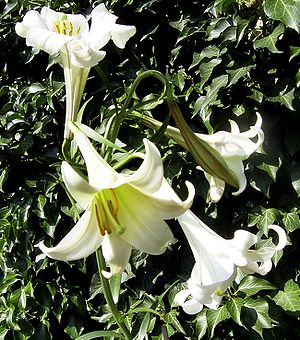Philippines lily
| Philippines lily | ||||||||||||
|---|---|---|---|---|---|---|---|---|---|---|---|---|

Philippines lily ( Lilium philippinense ) |
||||||||||||
| Systematics | ||||||||||||
|
||||||||||||
| Scientific name | ||||||||||||
| Lilium philippinense | ||||||||||||
| Baker |
The Philippines lily ( Lilium philippinense ) is a species from the genus of lilies ( Lilium ) in the trumpet lily section .
description
The Philippines lily reaches a height of between 30 and 90 cm. The egg-shaped, white to pale yellow, finely speckled purple onion occasionally forms runners , is 23 to millimeters high and 31 to 40 millimeters wide. The scales of the onion are ovate-elliptical, tapering to a point, up to 25 millimeters high and 13 millimeters wide. The stem is hairless, cylindrical and spotted green or brownish-red.
The thirty to forty leaves distributed around the stem are 10 to 15 centimeters long, around 2.4 centimeters wide, narrow, linear to lanceolate and smooth.
The Philippines lily blooms in July with one or two trumpet-shaped flowers that are almost cylindrical, very elongated in shape and only open wide at the end and stand on 2.5 to 4 centimeters long flower stalks. The six identical, bent-back bracts ( tepals ) are inverted-lanceolate, between 20 and 30 centimeters long and papillary at the base . The basic color of the pleasantly fragrant flowers is pure white, occasionally tinged with red or green at the base of the outside. The light green stamens are 15 to 18 inches long. The approximately 8 millimeter long anthers are linear to oblong-round and, like the pollen, are yellow, the stylus protruding above the anthers is green.
The seed of the Philippines lily germinates immediately and hypogeaically , the plants can reach flowering maturity within 8 months.
distribution
The Philippines lily is growing at the southernmost member of the genus, the species is in the mountains of the province of Benguet on the Philippine island of Luzon m in altitude from 1,500 to 2,300 endemic . There it grows in large clumps of several hundred individuals in meadows on rather poor, light soils in full sun to partially shaded, soaky moisture.
Naturalized populations are found in the United States in Florida around Tallahassee and in Kentucky .
Systematics
The species belongs to the Leucolirion section and is morphologically close to Lilium longiflorum and Lilium formosanum , with which the Philippines lily also hybridizes. Molecular genetic studies confirmed this and also brought them close to Lilium wallichianum .
Botanical history
The species was discovered in 1871 by G. Wallis during a trip through the Philippines, brought to England and sent to the then most famous European nursery, Veitch and Sons . It blossomed there for the first time in 1873 and was first described by John Gilbert Baker in the same year .
proof
- Henry John Elwes: A Monograph of the Genus Lilium , 1877, London
- Edward A. McRae: Lilies. A Guide for Growers and Collectors. , p. 176-177, 1998, ISBN 0-88192-410-5
- Mark Wood, Lily Species - Notes and Images , CD-ROM, July 13, 2006 version
Individual evidence
- ^ Plants Profile in the United States Department of Agriculture database
- ^ Flora of North America Editorial Committee, eds. 1993+, Flora of North America North of Mexico , 12+ vols, New York and Oxford, Vol. 26, 2002, p. 172
- ↑ Nishikawa Tomotaro, Okazaki Keiichi, Uchino Tae, Arakawa Katsuro, Nagamine Tsukasa: A Molecular Phylogeny of Lilium in the Internal Transcribed Spacer Region of Nuclear Ribosomal DNA , in: Journal of Molecular Evolution, 49, pp. 238-249, 1999
- ↑ Nishikawa Tomotaro, Okazaki Keiichi, Arakawa Katsuro, Nagamine Tsukasa: Phylogenetic Analysis of Section Sinomartagon in Genus Lilium Using Sequences of the Internal Transcribed Spacer Region in Nuclear Ribosomal DNA , in: 育種 学 雑 誌 Breeding science, Vol.51, No.1, pp. 39-46, 2001
